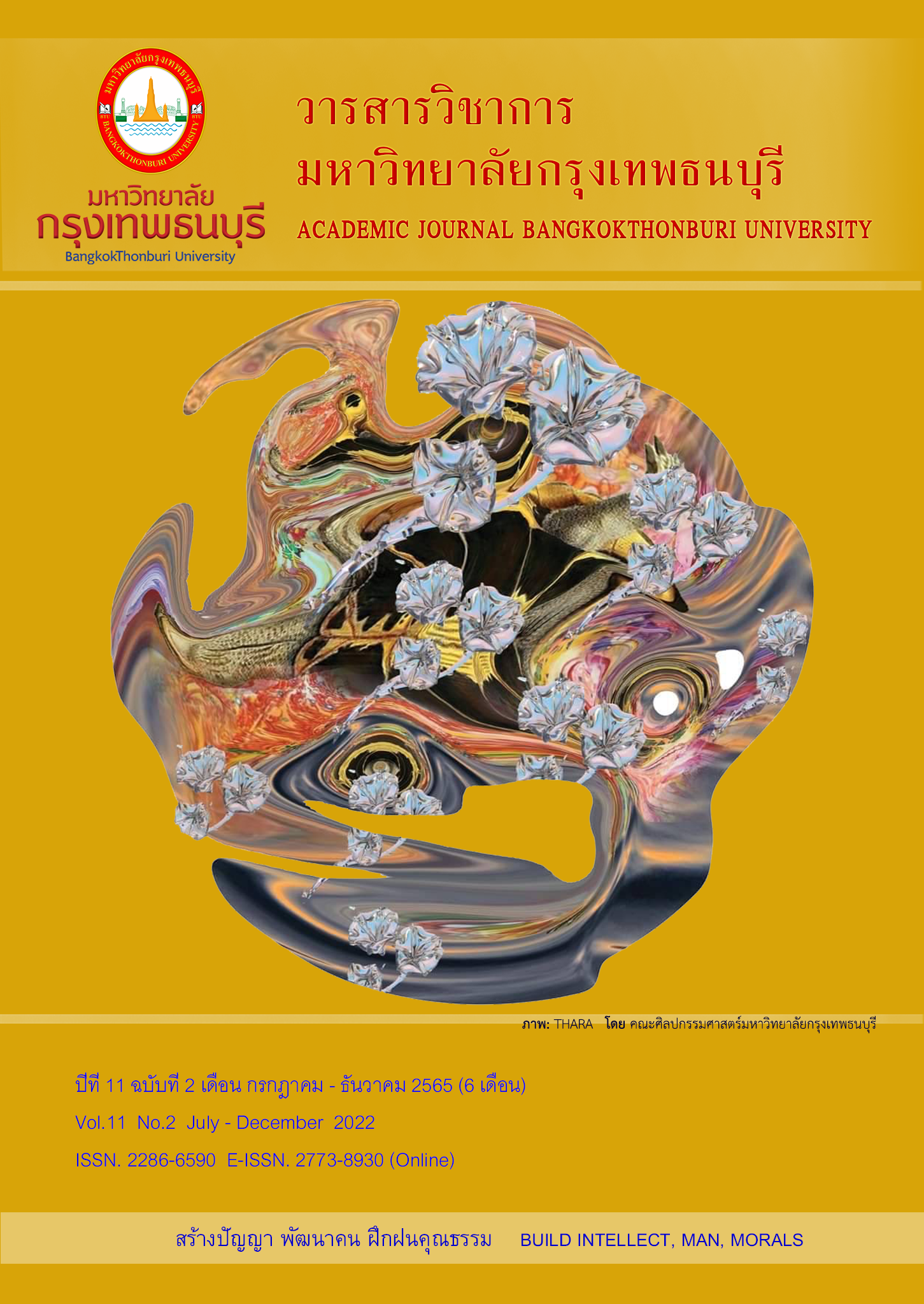Application of social media technology to promote learning styles of Mathayomsuksa 6 students in Bangkok Metropolitan Schools
Main Article Content
Abstract
This research the objectives are to 1) develop social media technology. To promote the ability to learning styles for students in Mathayomsuksa 6 schools under Bangkok 2) Compare the test scores before and after using social media technology. To promote the ability to learning styles for students in Mathayomsuksa 6 of Bangkok schools; and 3) to study opinions on the application of social media technology. To promote the ability to learning styles for students in Mathayomsuksa 6, schools affiliated with Bangkok. The samples used in the research He is a Mathayom 6 student at a school under Bangkok. obtained from a simple random method. By drawing lots from 9 schools, 9 classrooms with a total number of 270 students. The research tools were 1) social media technology 2) social media technology pre-test 3) media technology post-use test. Social Media
4) Social Media Technology Quality Assessment Questionnaire 5) Social Media Technology Application Opinion Questionnaire to promote talent for students in Mathayomsuksa 6, schools affiliated with Bangkok, and 6) Graza and Reizman's conceptual learning style measure, the statistics used in the data analysis were the efficacy and quality of social media technology, frequency values, values. Percentage Mean Standard Deviation and the t-test.
The results of the research showed that 1) social media technology to promote the ability to learn style for students in Mathayomsuksa 6, schools affiliated with Bangkok. as efficient as 83.33/85.78, content quality and media production at a very good level the students had the aptitude for learning by watching, of 112 people, representing 41.48%, followed by the aptitude for learning by doing, 94 students, accounting for 34.81 percent. 2) Test scores after using social media technology. online of students in Mathayomsuksa 6 Schools under the Bangkok Metropolitan Administration higher than the test scores before using social media technology with statistical significance at the level of .05 and 3) the opinions of Mathayom Suksa 6 students in schools under Bangkok as a whole, the opinions were at a high level. Can cause content memorization and increase long-term memory. It is essential to learning today. and the application of social media technology, YouTube, in learning are most appropriate, respectively.
Article Details

This work is licensed under a Creative Commons Attribution-NonCommercial-NoDerivatives 4.0 International License.
References
กันยปริณ ทองสามสี. (2564). ผลการจัดการเรียนรู้โดยใช้เทคโนโลยีสื่อบทเรียนออนไลน์เรื่อง การประกันสังคม. วารสารศึกษาศาสตร์ มหาวิทยาลัยนเรศวร, 23(3), 79-91.
ชนันท์ธิดา ประพิณ และคณะ. (2561). การพัฒนารูปแบบการจัดการเรียนรู้วิชาคอมพิวเตอร์ด้วยการเรียนแบบโครงงานเป็นฐานร่วมกับสื่อสังคมออนไลน์ เพื่อส่งเสริมการเรียนรู้เทคโนโลยีสารสนเทศและการสื่อสาร สำหรับนักเรียนระดับชั้นประถมศึกษาตอนปลาย. วารสารศึกษาศาสตร์ มหาวิทยาลัยนเรศวร, 21(1), 30-47.
ชัยยงค์ พรหมวงศ์. (2556). การทดสอบประสิทธิภาพสื่อหรือชุดการสอน. วารสารศิลปากรศึกษาศาสตร์วิจัย, 5(1), 7-19.
ณัฐกร สงคราม. (2553). การออกแบบและพัฒนามัลติมีเดียเพื่อการเรียนรู้. กรุงเทพฯ: สำนักพิมพ์จุฬาลงกรณ์มหาวิทยาลัย.
ดีไชน์นิลดอทคอม. (2557). 7 กฎการออกแบบ UI Design ให้สวยงาม สำหรับ Non-Designer (ตอน 2). (ออนไลน์). สืบค้นข้อมูลจาก https://www.designil.com/ 7-rules-beautiful-ui-design-part- 2.html.
ทิศนา แขมมณี. (2551). ลีลาการเรียนรู้. กรุงเทพฯ: สำนักพิมพ์แห่งจุฬาลงกรณ์มหาวิทยาลัย.
เทพยพงษ์ เศษคึมบง. (2555). ผลการเรียนด้วยอีเลิร์นนิงแบบเรียนรู้ร่วมกันผ่านสื่อสังคมออนไลน์ที่มีต่อความสามารถทางการใช้เทคโนโลยีสารสนเทศและการสื่อสารของนักศึกษาระดับปริญญาตรี สาขาครุศาสตร์/ศึกษาศาสตร์. Veridian E-Journal, SU, 5(2): 569-584.
ธนะวัฒน์ วรรณประภา. (2560). สื่อสังคมออนไลน์กับการศึกษา. วารสารศึกษาศาสตร์ มหาวิทยาลัยมหาสารคาม, 11(1), 7-20.
ปัณฑิตา อินทรักษา. (2561). การจัดการเรียนรู้ด้วยสื่อสังคมออนไลน์. วารสารศึกษาศาสตร์ มหาวิทยาลัยนเรศวร, 21(4), 357-365.
ปัณฑิตา อินทรักษา. (2562). การจัดการเรียนรู้ด้วยสื่อสังคมออนไลน์ วารสารศึกษาศาสตร์ มหาวิทยาลัยนเรศวร, 21(4): 357-365.
พิมพ์พจี ปณารัตน์. (2561). ผลการเรียนอีเลิร์นนิงร่วมกับการใช้สื่อสังคมออนไลน์เพื่อส่งเสริม ความสามารถในการใช้เทคโนโลยีสารสนเทศและการสื่อสารของนักศึกษาระดับปริญญาตรี มหาวิทยาลัยศิลปากร. วารสารศึกษาศาสตร์ มหาวิทยาลัยศิลปากร, 16(2), 88-98.
รัตติกร ภิรมย์โคร่ง. (2563). ลีลาการเรียนรู้และการใช้แหล่งเรียนรู้ของนักเรียนระดับชั้นมัธยมศึกษาปีที่ 1 โรงเรียนวัดไร่ขิงวิทยา. สาขาวิชาการศึกษาตลอดชีวิตและการพัฒนามนุษย์ ภาควิชาการศึกษาตลอดชีวิต บัณฑิตวิทยาลัย มหาวิทยาลัยศิลปากร.
ล้วน สายยศ และอังคณา สายยศ. (2553). เทคนิคการวิจัยทางการศึกษา. พิมพ์ครั้งที่ 11. กรุงเทพฯ: สุวีริยาสาสน์.
วราพร ดำจับ. (2562). สื่อสังคมออนไลน์กับการเรียนรู้ในศตวรรษที่ 21. วารสารศิลปศาสตร์ มหาวิทยาลัยแม่โจ้, 7(2), 143-159.
ศักดิ์คเรศ ประกอบผล. (2563). การวิเคราะห์ผู้เรียน: ลีลาการเรียนรู้. วารสารครุศาสตร์สาร, 14(2), 1-14.
สายพิน วงษารัตน์. (2564). การพัฒนาการจัดกิจกรรมการเรียนรู้ที่ประยุกต์ใช้เทคโนโลยีสื่อสังคม และบทเรียนออนไลน์ เพื่อส่งเสริมทักษะในศตวรรษที่ 21 ของนักเรียนชั้นมัธยมศึกษาปีที่ 6 โรงเรียนวิทยาศาสตร์จุฬาภรณราชวิทยาลัย เชียงราย. วารสารคุรุสภาวิทยาจารย์, 2(2): 45-55.
แสงเดือน ผ่องพุฒ. (2556). สื่อสังคมออนไลน์: แนวทางการนำ มาประยุกต์ใช้. สืบค้นจาก http://library.senate.go.th/document/Ext6685/6685991_0004.pdf
Creative Workline. (2015). Typography in Mobile Apps. (Online). Available from: http://www.creativeworkline.com /2015/07/typography-in-mobile-apps/
Elaine McVicar. (2014). Designing for Mobile Part 3: Visual design. (Online). Available from: https://www.uxbooth.com/articles/designing-mobile-part-3-visual-design/
Fleming, N.D. & Mills, C. (1992). VARK a guide to learning styles. Retrieved from https://vark-learn.com/introduction-to-vark/the-vark-modalities/
Iren Korkishko. (2017). UI/UX design guide with terms, explanations, tips and trends. (Online). Available from: https://medium.com/swlh/ ui-ux-design-guide-with-terms-explanations-tips-and-trends-754b9356d914
Marjorie Vai and Kristen Sosulski. (2011). Essentials of Online Course Design. New York: Routledge.
Mehraj A, B.. (2014). Understanding Learning Styles of Secondary School Students in Relation to certain Variables, Asian Journal of Multi Discipline. 2(11), 1-8.
Taylor, A. (2014). A Look at Web-based Instruction Today: An interview with Badrul Khan, Part 1. eLearn Magazine. A Publication of ACM. Retrieved from http://elearnmag.acm.org/ archive.cfm?aid=2590180
VARK Learn Limited. (2020). VARK Strategies: Strategies Matched to VARK Preferences. Retrieved from https://vark-learn.com/strategies/


